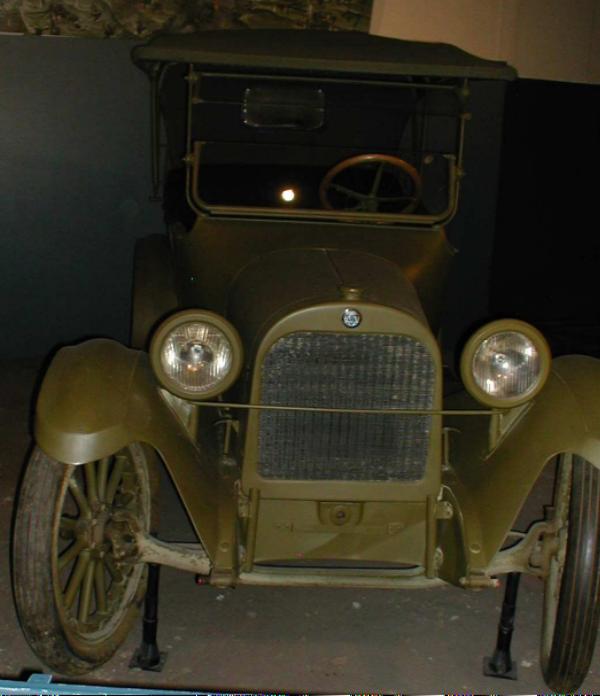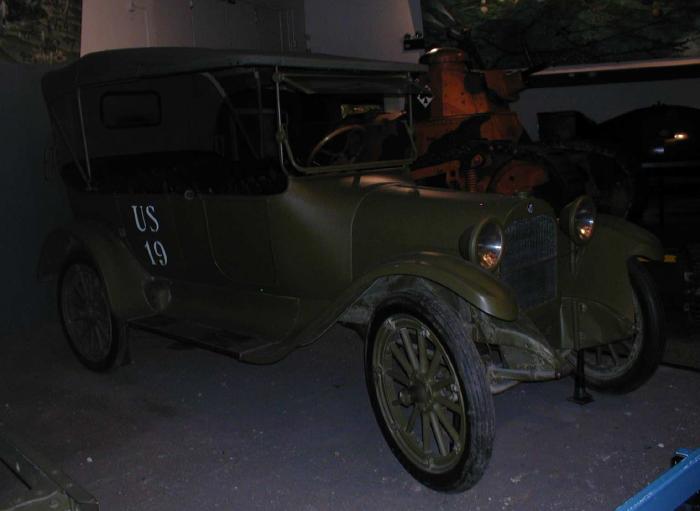
Dodges in the Military
Before World War I
The first motor vehicles used in actual combat by the U.S. Army were the 1916 Dodge touring cars in which forces under the command of General John T. Pershing pursued and engaged Pancho Villa following Villa's raid on Columbus, New Mexico, March 6, 1916. A young Army Lieutenant, George S. Patton, saw his first motorized combat as a member of this "punitive expedition." The success of these Dodge cars in cross country operations gained them a high priority on the Army's procurement list for World War I.
vvvvvvvvvvvvvvvvvvvvvvvvvvvvvvvvvvvvvvv
Dodges in the Military - World War I
Dodge trucks were not produced as such until 1927. The common practice by automobile manufacturers, including Packard and Pierce-Arrow, was to produce "commercial cars" based on their standard automobile chassis and delivered to coach builders for completion with purpose built bodies. This practice continues today with the production of cab and chassis or chassis only vehicles. The US Army used standard Dodge sedans and commercial cars extensively in World War I. One of the most common commercial cars was an ambulance. Some commercial cars used locally fabricated box, stake, and flat beds in performing their various missions. These various Dodges performed well and earned Dodge a reputation for building rugged, dependable vehicles.
According to a prominent Dodge historian, General Pershing's Dodge car is displayed at the museum at West Point. Reportedly, George Patton had a preference for the Dodge and his Dodge is displayed in the museum at Aberdeen Proving Grounds. I visited West Point to verify the "Pershing Dodge" information. There is a 1916 Dodge displayed there. Here is the car and the Museum information placard. I apologize for the photo quality. Flash pictures were not allowed.



According to a senior member of the Museum staff, General Pershing was believed to have traveled only in closed sedans. The claim that this particular car was used by General Pershing was made by the French farmer who was selling it some years after the end of World War I.
vvvvvvvvvvvvvvvvvvvvvvvvvvvvvvvvvvvvvvvv
Dodges in the Military - Between the World Wars
In the period following "the War to End All Wars" the United States reverted to isolationism. The military was "downsized" to the point that it was not capable of being the "big stick" that 'Teddy' Roosevelt wanted to carry. The War Department sporadically engaged in weapons and equipment procurement with all the military factions competing for their own systems with no tolerance for other military branches or weapons systems. Obviously this process was less than effective.
Following Chrysler's purchase of Dodge in 1927, production of the full line of Dodge trucks began under the Dodge name. From the beginning, Dodge engineers produced trucks that had the most modern engineering advances. Dodge trucks were designed and built to provide the widest range of capabilities for private individuals and corporate customers. When different government departments needed trucks, Dodge was ready. Truck engineers were able to design and produce trucks to meet procurement specifications in minimum time by combining proven components. This "parts box" engineering served Dodge well for producing trucks and it serves us well for keeping them running.
As the long range effects of downsizing became apparent, US military might was no longer a factor for deterring those who aspired to make war. Japan began to spread its empire into the Asian continent and many island nations in the Pacific. Germany ignored the terms of the Versailles Treaty and began to equip what would be at the time the most modern military force on our planet. As the threat of another World War increased, President Roosevelt continually spoke of neutrality but increased production of war materiel. Under the banner of neutrality, the US began to supply military equipment, ammunition, and other supplies under the "Lend-Lease" programs. Dodge was right there producing a variety of military trucks. Most of the Dodge 1/2 ton military trucks that saw combat in World War II were those shipped to Great Britain as "Lend Lease" aid. They were extensively deployed in Northern Africa where the rapidly alternating successes in battle saw them captured by the Germans and recaptured by the Allies. Military historians estimate that 85% of all German support and transport vehicles at the time of the conclusion of the North Africa campaign were captured Allied equipment. Remember that Germany was defeated as much by interdiction of supply as by actual combat so that estimate is 85% of not a whole lot. Generally, the only Dodge WC 1/2 tons shipped overseas for use by the US Army were those sent to the Philippines prior to World War II where they were captured by the Japanese who used them during the war.
vvvvvvvvvvvvvvvvvvvvvvvvvvvvvvvvvvvvvvv
Dodges in the Military - World War II
In the first months of World War II, the major combat activity by US forces was the Naval Campaigns against the Japanese in the Pacific. These alternated between defensive and offensive operations. The boldness of the Pearl Harbor attack created a general fear that the Japanese would invade the west coast. Generally, all activities by ground forces in western United States were defensive. New coastal defenses were built. Existing ones were upgraded.
One defensive operation was particularly notable for having been conducted with an intensity that equaled or surpassed that of any offensive campaign of the entire second World War. That was building the Alcan Highway. Construction of this highway officially began on March 8, 1942 and ended eight months and 12 days later on October 25, 1942. Alaska was considered vulnerable to a Japanese invasion. The general route of the highway was along a line of existing airfields from Edmonton AB, to Fairbanks, Alaska. This chain of airfields was known as the Northwest Staging Route and was used to ferry more than 8,000 war planes from Great Falls, Montana to Ladd Air Base in Fairbanks. In June 1942 the Japanese invaded Attu and Kiska in the Aleutians, adding a new sense of emergency.
Some photo archives show Dodge WC 1/2 ton military trucks on the Alcan Highway but I have not been able to determine if they were there to support the highway project or to support the chain of airfields along the highway route.
It was many months before US troops were meaningfully deployed into ground combat. The Army felt the WC 1/2 tons were not rugged enough for use in combat areas. Dodge responded and the WC 3/4 ton military series were in full production by then. The major exception was that many WC 1/2 ton ambulances saw service with the US Army Air Forces at air bases in England where they were operated only on improved terrain. WC 3/4 ton military series Dodges were used in all theaters of WW2. Production of the WC 3/4 ton military trucks was terminated in 1945. When the war was over, many combat units were inactivated and much of their equipment was left in place for use by local military and civil authorities in the post-war reconstruction.
vvvvvvvvvvvvvvvvvvvvvvvvvvvvvvvvvvvvvvv
Dodges in the Military - POST World War II to Viet Nam
Our World War II military leaders - many of whom served in World War I - began to retire. This left the "new guys" in charge. Many of them had risen in rank at a rate unprecedented in periods of peace. Now they had to dig in and establish their "empires" in order to prevail. The emergence of air power in securing the victory resulted in establishing the United States Air Force as a separate military department. Aircraft carriers and submarines were recognized as the ultimate choices for naval warfare and the great battleships joined the "mothball" fleets. The role of infantry was reassessed in view of the successes of armor and artillery - first demonstrated by the German "blitzkrieg" at the outset of the War. Predictably, the active military was "downsized" again.
Many WC 3/4 ton military series trucks still in the greatly reduced active Army were deployed to Korea and were used for most of that combat. The M-37 replacements did not get to Korea in any great numbers before the truce. The M-37 family was the mainstay of the "Cold War". They saw extensive service in Europe as well as the beginnings of the Viet Nam war. When the M-715 1&1/4 ton Kaiser-Jeep replacements were fielded, the M-37's were brought back from Europe - probably a State Department deal to keep our surplus vehicles from competing there with vehicles being produced by our "friends" in Europe. All "stateside" surplus M-37 series vehicles went to other government (forest service, etc) and civil defense agencies and were not generally available for purchase by the public. Now, after twenty years, they have all been released and are available in great numbers - comparatively speaking.
vvvvvvvvvvvvvvvvvvvvvvvvvvvvvvvvvvvvvvvv
Dodges in the Military - POST VIET NAM and MORE cold war
After our victory
stalemate
defeat learning opportunity in Viet Nam, the Army refocused on the real
mission - defeating the Warsaw Pact in the recurring "Fulda Gap" type scenario.
Having been forced to accept the relative impotence of armor in rice paddies, it
gave those who now called themselves "Warriors" a real testosterone rush to
concentrate on the air-land battle with tanks that were too wide to get through the narrow
streets of many "friendly" towns and villages. This "bigger is
better" idea was carried over into the Army's quest for a really great support
vehicle in the 1&1/2 ton range. The goal was to have all our vehicles able to keep up with
tanks at any speed over any terrain. Can you say, "Gamma Goat"? The
"Gamma Goat" did not do ... (Add any word here!)
The lessons of history sent the Army back to Dodge and the M-880 series. The commercially available Dodge 4x4 was used successfully by thousands of hunters, contractors, fishermen, and other off-road enthusiasts in the widest range of conditions. Apparently the Army selected a panel of Second Lieutenants who had never driven any 4x4 vehicle or American designed automobile and had them set the equipment specifications. Military NDT's would have been better than the M-880's wimpy "all-season" tires that ten years earlier would never have been considered the equal of any available "mud and snow" tires. This was a time that the Army was taking in many new recruits who had never driven any vehicle - or at least nothing more potent than a Yugo with automatic transmission. Most of these "first-time, off-roaders" had no experience or skills, but that did not keep them from driving beyond their abilities and demonstrating the M-880's shortcomings. And so the Dodges got a bad rap. There was nothing wrong with an M-880 that could not have been fixed with a trip to the local Off-Road store.
With the right incentives to the right officials, Chevrolet got the follow on procurement. While their civilian truck advertisements touted their selection by the military, motorpools around the world were dealing with cracked and broken truck frames on the CUCV's.
Let's see... Which corporate
political contributor has been left out? Oh, yes. It's AM General. I
find it questionable interesting that this was the first military
procurement action that let a vehicle designed for combat activities also be sold new to
the public. Does it bother anyone else that Clinton made it hard to bring a veteran
Dodge back into the USA because of its potential use as an "urban assault
vehicle" or "weapon of mass destruction" while dealers across the USA sell
Hummers? And what about the efforts of (D)Senator
Levin of Michigan to have the government seize all former military vehicles now
owned by collectors?
vvvvvvvvvvvvvvvvvvvvvvvvvvvvvvvvvvvvvvvvvvvvvvvv
Vehicles in the Military - Comments by The New York Times
http://www.nytimes.com/2003/03/30/automobiles/times-war-detroit-enlists-pancho-villa-persian-gulf-missions-become-motorized.html